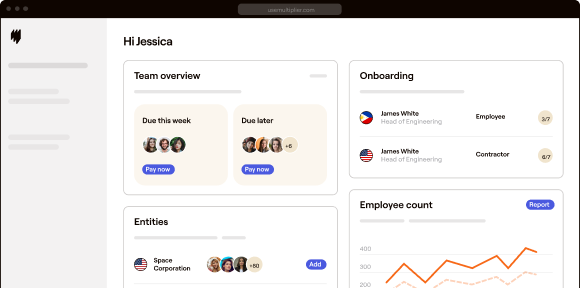Managing a workforce is a challenging task, especially when it comes to global enterprises with employees spread across many regions. This is something business leaders and HR know all too well. One of the primary responsibilities of the HR department is to ensure a perfectly functioning workforce that always aligns with the company’s present and future needs. That’s where staff planning comes in.
Global staff planning is vital to strategize human resources in a way that efficiently meets present and future business requirements. It aims to assess which human resources a business needs, when it needs them, and for how long. In this blog post, we’ll look closely at staff planning and the fundamentals of effective headcount planning.
Introduction to staff planning
Staff planning is a strategic imperative for building robust workforce foundations that can effectively meet industry demands and fulfill long-term business objectives. As HR departments navigate complex hiring and staffing shortages, they need tools and processes that enable them to be proactive and agile.
Global staff planning is designed to help companies keep pace with evolving market demands through cross-training, compliance standards, and workforce management. By leveraging technology in this area, you can build a resilient, adaptable workforce that can weather the storms of any industry and come out stronger on the other side.
The fundamentals of staff planning
The primary focus of staff planning is assessing a company’s current and future staff requirements to keep up with the ever-changing talent demand, both present and predicted. It’s an ongoing process that requires the utmost attention and commitment from the HR team. The core components of staff planning encompass various crucial steps, including:
- Developing accurate job descriptions: Creating accurate job descriptions is essential for defining the roles and responsibilities of each position within the organization. This involves identifying the critical skills, qualifications, and experience required for a specific role. By developing accurate job briefs, organizations can ensure that they hire the right people for the right job, leading to a more efficient and productive workforce.
- Skill gap analysis: Skill gap analysis plays a crucial role in staff planning by identifying the difference between skills that employees currently possess and the skills required for the successful execution of their roles. This process enables organizations to pinpoint areas where training or hiring might be needed to bridge the identified gaps.
- Identifying the necessary toolkits: This involves determining the resources, software, equipment, and training materials that employees need to perform their duties effectively and efficiently. The right toolkit can enhance productivity, foster innovation, and facilitate communication and collaboration among team members.
- Defining job preferences and positions: By clearly outlining the desired qualities and responsibilities for each position, organizations can ensure that they recruit and assign the right individuals to the appropriate roles. This helps maintain alignment between individual and organizational goals.
- Building comprehensive succession plans: Succession planning is another critical element of staff planning. It involves identifying potential successors for key organizational positions and developing a plan to prepare them for future leadership roles. By implementing succession plans, organizations can avoid disruptions in leadership and productivity.
However, one of the most challenging aspects of global staff planning is navigating the intricate web of regional and national regulations while considering varying cultural factors. Balancing compliance with local labor laws and regulations while meeting the demands and expectations of a global workforce adds complexity to the already tricky process.
It requires a nuanced approach and a deep understanding of each region’s legal and cultural landscape to ensure that the organization meets its staffing needs effectively and remains compliant with all relevant regulations.
Understanding headcount planning
Within an organization, the success of staff planning and headcount planning are closely linked. Staff planning is vital for business continuity, while headcount planning is essential to building a workforce to fulfill business objectives. The headcount planning process involves a series of strategic and tactical steps that ensure the organization has the correct number of employees with the right skills and roles at the right time.
The first step in the process is to examine the historical data, current trends, and future growth plans to determine the required number of employees. Once a target is set, the organization can create a headcount forecast. This forecast can be based on specific criteria, such as an expected rise in sales or the introduction of a new product, and helps to project future hiring needs.
With the forecast completed, the organization can review existing talent and identify any gaps that need to be filled through recruitment or further training and development.
When executed thoroughly, headcount planning can help organizations ensure that they have a workforce that aligns with their long-term objectives, leading to better business outcomes.
Staff planning best practices
Effective staff planning is vital to the success of any organization, whether it’s a small startup or a multinational corporation. Proper planning contributes to developing a dedicated, high-performing team to accomplish your company’s goals.
Due to the complexity of staff planning, it’s essential to identify and implement some best practices. Global staff planning, for example, entails more than just monitoring headcount; one must consider factors such as local labor market trends and anticipated business growth. Below are some essential staff planning best practices to ensure your organization has the talent it needs to succeed:
- Create clear job descriptions that accurately outline the qualifications, expertise, and responsibilities required for the position.
- Strategize headcount planning based on projections of future business requirements.
- Analyze workforce strengths and weaknesses to ensure your team is structured to achieve your objectives.
- Develop future leaders and bench strength for critical roles.
- Introduce flexibility into your workforce planning so that you can quickly shift resources as required.
By following these best practices, businesses can maintain a healthy workforce and positively impact performance.
Conclusion
Effective workforce management is paramount for all businesses, with staff planning as its cornerstone. In today’s evolving landscape of HR, where data-driven approaches are becoming increasingly prevalent, it’s crucial to incorporate analytical methods and leverage technology to make informed decisions.
Investing in valuable tools and resources that optimize HR management processes can unlock new opportunities to generate value for your organization, drive employee engagement, and foster a thriving work environment.
Enhance staff planning with Multiplier
Multiplier’s advanced workforce management and EOR solution offers a broader view of your business and its workers, helping to enhance processes such as global staff planning. Our platform offers the utmost efficiency and transparency and introduces automation to handle tedious and time-consuming tasks. Leaving you with more time and freedom to focus on the core areas of your business. Want to know more? Talk to our experts.
FAQs
Q. How often should we conduct staff planning sessions?
Annual staff planning is a common practice for many companies, although its frequency varies based on factors such as company size, structure, and goals. It is crucial to optimize word choice, structure, readability, and eloquence while preserving the original meaning.
Q. Are there any software tools for automating headcount forecasting?
Several software tools are available for automating headcount forecasting. These tools help in planning the workforce, breaking down hiring costs, and staying within budget. Some of them can even save up to 30 hours per month by automating busy work and keeping financial forecasts updated in real time.
Q. What role does workforce diversity play in staff planning?
Workforce diversity is vital, but it should not be the exclusive focus of staff planning. A diverse workforce can add value to your organization, enhance innovation, and improve talent acquisition.
Q. How can organizations adjust headcount plans during economic downturns?
Organizations must be adaptable and agile while adjusting their headcount plans. Reductions in the workforce must be handled with care and sensitivity while keeping the organization’s long-term goals in mind.







